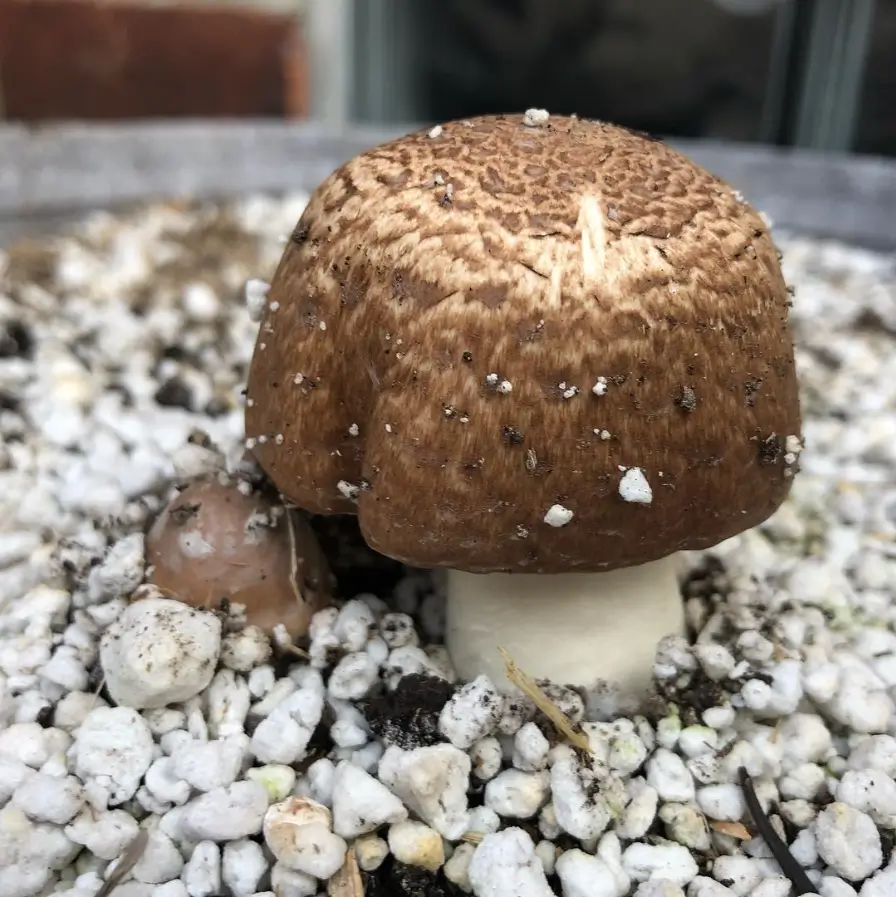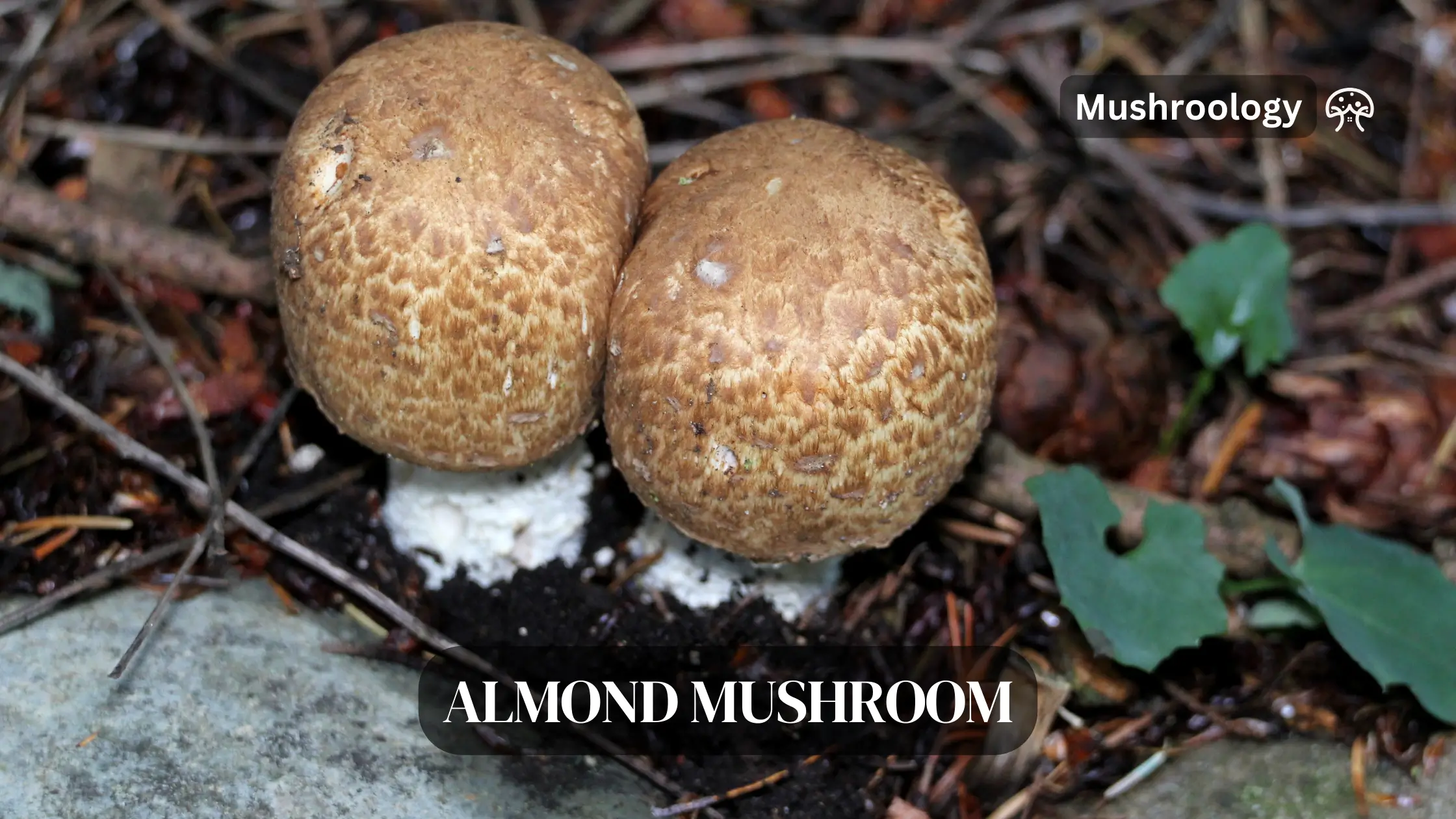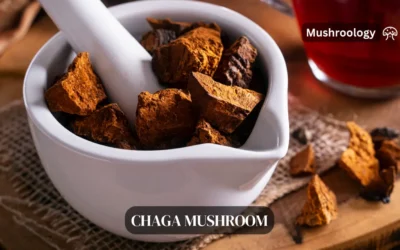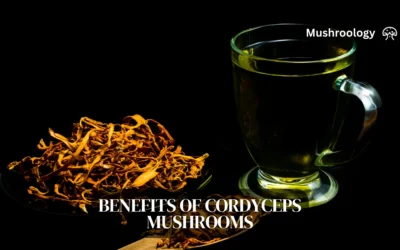Growing Almond Agaricus (Agaricus subrufescens) mushrooms at home requires careful preparation and attention to detail to ensure successful and productive growth.
These mushrooms are known for their sweet, almond-like flavour and potential health benefits. Here’s a detailed guide on preparing the substrate for your Almond Agaricus mushrooms.
Types of Substrates for Growing Almond Agaricus Mushrooms

Almond Agaricus mushrooms thrive in a variety of compost-based substrates. The choice of substrate is crucial as it provides the necessary nutrients and environment for the mushrooms to grow. Below are some of the substrates that can be used:
1. Composted Plant Matter and Manure
Almond Agaricus mushrooms prefer rich, decomposed plant matter. A mix of spent and composted substrates, such as Shiitake (sawdust) blocks and mycelial, composted oyster mushroom straw, can be used. This “dual waste” substrate approach allows for the efficient use of resources and supports sustainable cultivation practices.
2. Agro-Residues
Studies have shown that compost mixed with selected agro-residues like woodchips (25%) and corncob (25%) can produce better yields. This mix not only supports the growth of Almond Agaricus mushrooms but also utilizes agricultural by-products, making it an environmentally friendly optionAlmond Agaricus.
3. Straw-Bedded Horse Manure and Hay or Wheat Straw
Common bulk ingredients for the mushroom substrate include straw-bedded horse manure and hay or wheat straw. These materials are widely used in the mushroom industry for their availability and effectiveness in supporting mushroom growth.
4. Crop Straws
Crop straws, such as rice straw, wheat straw, corn straw, and cottonseed shell, along with compost and sawdust, have been identified as suitable substrates for Almond Agaricus cultivation. These substrates offer a balance of nutrients and physical properties conducive to mushroom growth.
5. Fully Finished Compost
Fully finished compost, where the starting material is no longer recognizable, is essential for Almond Agaricus cultivation. This type of compost provides a nutrient-rich environment for the mushrooms. It’s important that composts made with animal manure are fully composted prior to use to avoid any potential issues.
6. Peat Moss with Vermiculite (Casing Layer)
While not a primary substrate, a casing layer of peat moss with vermiculite can be applied to the surface of the compost bed. This layer helps maintain moisture and encourages the development of mushroom pins. It’s an optional step that can enhance yields.
Preparing the Substrate
Materials Needed
- Fully finished compost (10 lbs per sq. ft. of bed space, 5 inches deep)Almond Agaricus
- Almond Agaricus spawn (1/2 lb. per sq. ft.)Almond Agaricus
- Watering can or hose with a spray nozzle
- Mulch material (optional, for moisture retention)
Steps for Substrate Preparation
- Choose the Right Compost: Almond Agaricus mushrooms prefer rich, decomposed plant matter. Use composted materials like woodchips, corncob, or a mix of spent and composted mushroom substrates. The compost should be fully finished, meaning you can’t tell what the starting materials were.
- Moisture Content: The compost should have a moisture content of 60-70%. To test, grab a handful of compost and squeeze it. It should stick together in a clump and show water on your hand when released.
- Prepare the Bed: Lay out your compost in the desired location for your mushroom bed. The bed should be approximately 5 inches deep. If using pots or planters, fill them 1/2 to 2/3 full with moistened potting soil before adding the compost.
- Inoculation: Break the Almond Agaricus spawn into small, egg-sized pieces and mix it evenly with the substrate. Ensure that the spawn is well-distributed throughout the compost.
- Maintain Moisture: After inoculation, maintain the moisture content of the substrate. This may require regular watering, especially in protective structures like greenhouses where natural rainfall is absent. A mulch layer can help retain moisture and reduce the need for frequent watering.
- Monitor Mycelium Growth: Over the next few weeks, watch for the growth of white mycelium on the compost surface. This indicates that the spawn is colonizing the substrate.
- Casing Layer (Optional): Consider adding a casing layer for increased yields. This is a thin layer of nutrient-poor, water-holding material that can help maintain bed moisture and reduce the need for constant watering.
Almond Agaricus Mushroom Care
Light
These mushrooms require indirect light to initiate the fruiting phase. Direct sunlight should be avoided to prevent drying out the substrate.
Soil
The “soil” for Almond Agaricus is essentially the composted substrate. Ensure it’s fully composted and has the right moisture content.
Water
Maintain the substrate’s moisture by watering lightly but regularly. Overwatering can drown the mycelium, while under-watering can halt its growth.
Temperature and Humidity
Keep the growing area at temperatures between 70-90°F (21-32°C) during the incubation phase. For fruiting, a slight decrease in temperature and exposure to higher humidity levels is beneficial.
Fertilizer
Almond Agaricus mushrooms do not require traditional fertilizers. The nutrients in the composted substrate provide all the necessary food for growth.
During the incubation period, it’s crucial to monitor the temperature and moisture levels of the substrate. The substrate should remain moist but not waterlogged. If the substrate appears to be drying out, mist it lightly with water. However, be cautious not to overwater, as this can lead to the growth of unwanted bacteria and molds.
Transitioning to Fruiting
Once the substrate is fully colonized by the mycelium, it’s time to initiate the fruiting process. This involves changing the environmental conditions to signal the mycelium to produce mushrooms.
Varieties of Almond Agaricus Mushrooms
While specific varieties of Almond Agaricus are not commonly differentiated, genetic research and cultivation methods are continuously evolving, potentially leading to the development of new strains with enhanced qualities.
Harvesting
Harvest Almond Agaricus mushrooms when the veil between the mushroom cap and stem is mostly intact. This stage indicates maturity while preserving the mushroom’s quality and flavor.
Propagating
Propagation of Almond Agaricus mushrooms is primarily through the inoculation of new substrates with spawn. Unlike plants, mushrooms are propagated through spores or mycelial fragments rather than seeds.
Growing Almond Agaricus mushrooms at home is a rewarding endeavor that offers health benefits, culinary enjoyment, and potential commercial opportunities. By following these detailed steps and providing the right care, you can successfully cultivate these nutritious and flavorful mushrooms in your own space.
FAQs for Growing Almond Agaricus Mushrooms
1. What is the best time to plant Almond Agaricus mushrooms?
Plant Almond Agaricus (Agaricus subrufescens) after the last frost date in your area to ensure at least 2-4 months of frost-free weather for optimal growth.
2. What type of substrate is ideal for Almond Agaricus mushrooms?
A fully finished compost, which can include a mix of plant matter and manure, is ideal. The substrate should have a moisture content of 60-70%.
3. How do I inoculate the substrate with Almond Agaricus spawn?
Break the spawn into golf ball-sized chunks and bury them at least an inch down into the compost bed, spaced about 4-6 inches apart.
4. What are the temperature requirements for growing Almond Agaricus mushrooms?
During the incubation phase, maintain temperatures between 70-90°F (21-32°C). The mushrooms are cold-sensitive and will only produce as long as temperatures stay above 40°F (4°C).
5. How often should I water my Almond Agaricus mushroom bed?
Watering frequency depends on the environment; outdoor beds may receive enough rainfall, but beds in grow structures may need watering every other day if conditions are hot and dry.
6. Is a casing layer necessary for Almond Agaricus mushrooms?
While not necessary, a casing layer can provide added humidity protection and help increase yields. It should be wet enough to release about 10 drops of water when squeezed.
7. How do I know when to harvest Almond Agaricus mushrooms?
Harvest when the veil between the mushroom cap and stem is mostly intact, which indicates maturity while preserving quality and flavor.
8. Can Almond Agaricus mushrooms be grown indoors?
Yes, they can be grown “small scale” in window boxes or large potted plants, indoors or out, as long as the environmental conditions are met.
9. What are the benefits of growing Almond Agaricus mushrooms?
Almond Agaricus mushrooms are known for their sweet, almond-like flavor and potential health benefits, including medicinal properties.
10. Can Almond Agaricus mushrooms tolerate cold temperatures?
The mycelium can survive some freezing weather, but developing baby mushrooms will not. It’s best to pack in as much growing season as possible.





